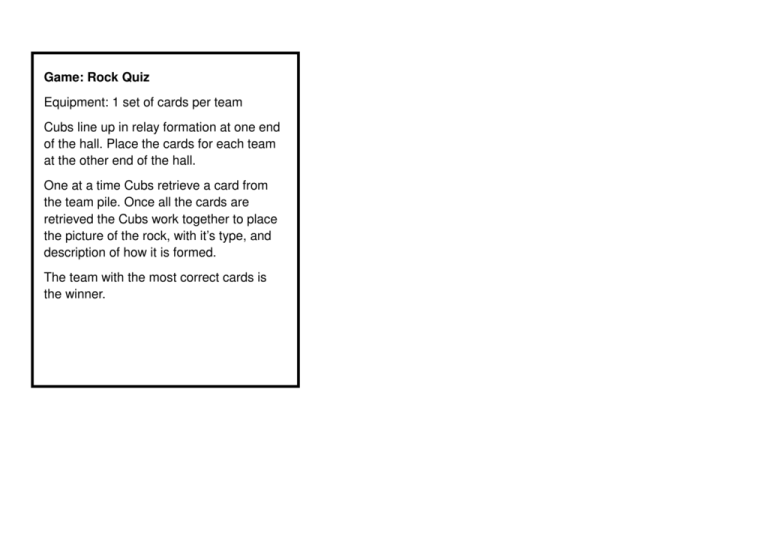Rock Quiz
advertisement

Game: Rock Quiz Equipment: 1 set of cards per team Cubs line up in relay formation at one end of the hall. Place the cards for each team at the other end of the hall. One at a time Cubs retrieve a card from the team pile. Once all the cards are retrieved the Cubs work together to place the picture of the rock, with it’s type, and description of how it is formed. The team with the most correct cards is the winner. Conglomerate—made up of rounded pebbles cemented together Sandstone—sand grains cemented together into solid stone Shale—silt particles cemented Marble—is a metamorphic rock that comes from limestone or dolomite Slate—is a fine grained metamorphic rock Gneiss—a medium to course grained metamorphic rock Basalt —is a hard, black volcanic rock Obsidian—is usually back in colour. It is a dense volcanic glass. Rhyolite—is a light-coloured volcanic rock Sedimentary Metamorphic Igneous These rocks are formed from particles of sand, shells, pebbles, and other fragments of material. May be soft and break apart or crumble easily. These rocks are formed under the surface of the earth from the change that occurs due to intense heat and pressure. These rocks often have ribbon like layers and may have shiny crystals. These rocks are formed when magma cools and hardens. May look shiny and glasslike. Sometimes gas bubbles are trapped in the rock while forming leaving tiny holes and spaces in the rock. Types of Rocks Rocks are not all the same! The three main types, or classes, of rock are sedimentary, metamorphic, and igneous and the differences among them have to do with how they are formed. Sedimentary Sedimentary rocks are formed from particles of sand, shells, pebbles, and other fragments of material. Together, all these particles are called sediment. Gradually, the sediment accumulates in layers and over a long period of time hardens into rock. Generally, sedimentary rock is fairly soft and may break apart or crumble easily. You can often see sand, pebbles, or stones in the rock, and it is usually the only type that contains fossils. Examples of this rock type include conglomerate and limestone. Metamorphic Metamorphic rocks are formed under the surface of the earth from the metamorphosis (change) that occurs due to intense heat and pressure (squeezing). The rocks that result from these processes often have ribbon like layers and may have shiny crystals, formed by minerals growing slowly over time, on their surface. Examples of this rock type include gneiss and marble. Igneous Igneous rocks are formed when magma (molten rock deep within the earth) cools and hardens. Sometimes the magma cools inside the earth, and other times it erupts onto the surface from volcanoes (in this case, it is called lava). When lava cools very quickly, no crystals form and the rock looks shiny and glasslike. Sometimes gas bubbles are trapped in the rock during the cooling process, leaving tiny holes and spaces in the rock. Examples of this rock type include basalt and obsidian.







